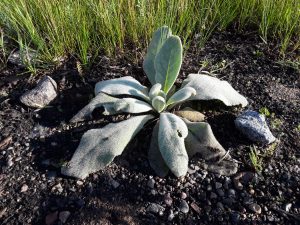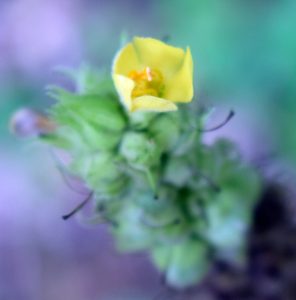Common Mullein

Verbascum thapsus is a biennial plant, which means it takes 2 years to complete its life cycle. The first year, the basal leaves are covered with soft hairs, as pettable as cat fur or even chinchilla, so velvety soft they are! Mullein sends up a huge stalk in its second year with an up to 2 foot tall spike of yellow flowers blooming June through September. These dry later into brown pods, persisting on the racemes (spikes) through winter — a decorative addition to fields and roadsides. Other names the common mullein goes by are equally descriptive: flannel plant, hare’s beard and velvet plant. It has also been called cowboy toilet paper…easy to see why.
 Common mullein is not a native plant to N. America (origin is N. Africa and Eurasia), but in Minnesota it is not a particularly pesky plant either. Mullein has a rich medicinal history that continues today with modern, herbal practitioners for a variety of symptoms and conditions. All parts of the plant are useful. The leaves (which Tribal Nations also traditionally smoke for its medicine) draw up minerals from the soil, so assuming you have non contaminated soil try a cup of infused mullein tea for a day’s dose of calcium and magnesium. Mullein oil (made from the flowers) is especially successful and commonly used in relieving earache, applied directly in the ear. I have dried mullein leaves in my cupboard which I use for as an expectorant for coughs and to treat chronic bronchitis (soothes the respiratory system). The list goes on.
Common mullein is not a native plant to N. America (origin is N. Africa and Eurasia), but in Minnesota it is not a particularly pesky plant either. Mullein has a rich medicinal history that continues today with modern, herbal practitioners for a variety of symptoms and conditions. All parts of the plant are useful. The leaves (which Tribal Nations also traditionally smoke for its medicine) draw up minerals from the soil, so assuming you have non contaminated soil try a cup of infused mullein tea for a day’s dose of calcium and magnesium. Mullein oil (made from the flowers) is especially successful and commonly used in relieving earache, applied directly in the ear. I have dried mullein leaves in my cupboard which I use for as an expectorant for coughs and to treat chronic bronchitis (soothes the respiratory system). The list goes on.
For fun, try lighting the dried raceme (carefully) as a torch around the campfire, or lean over from the trail to shake one for a pleasant ratting sound.
